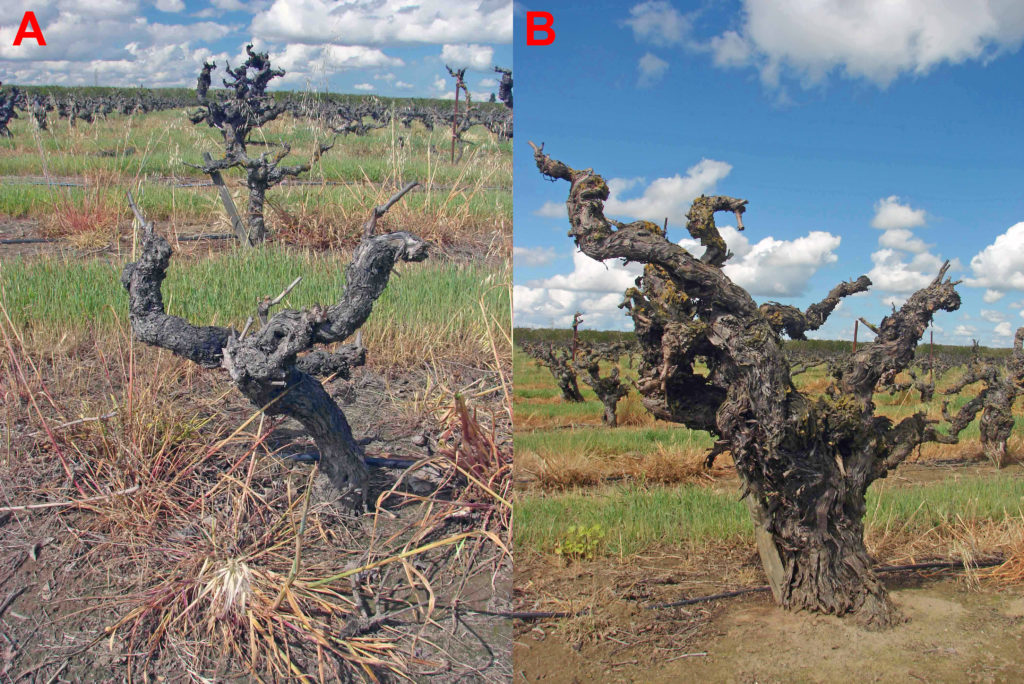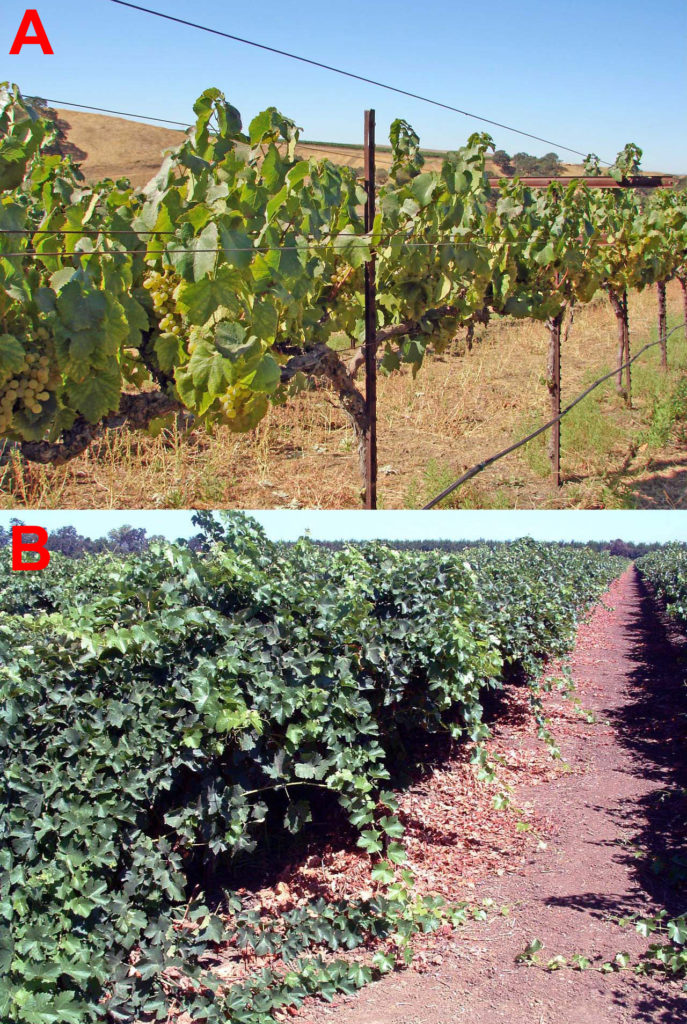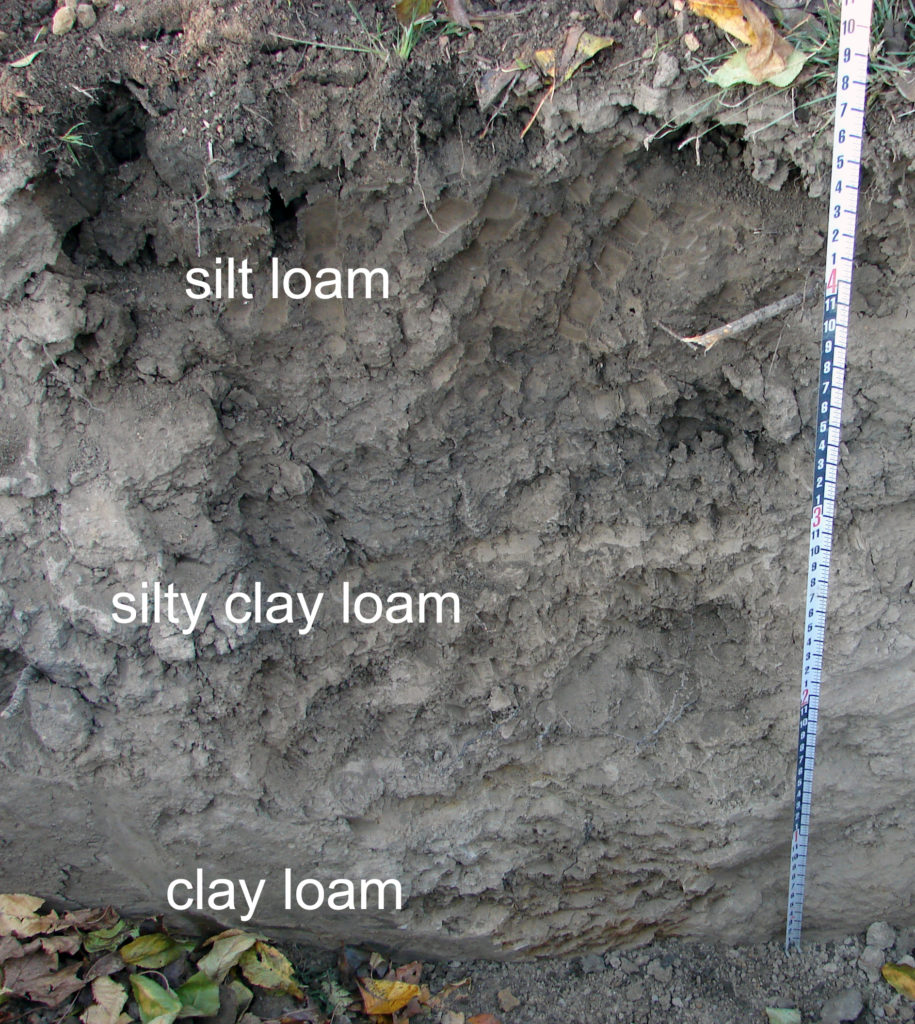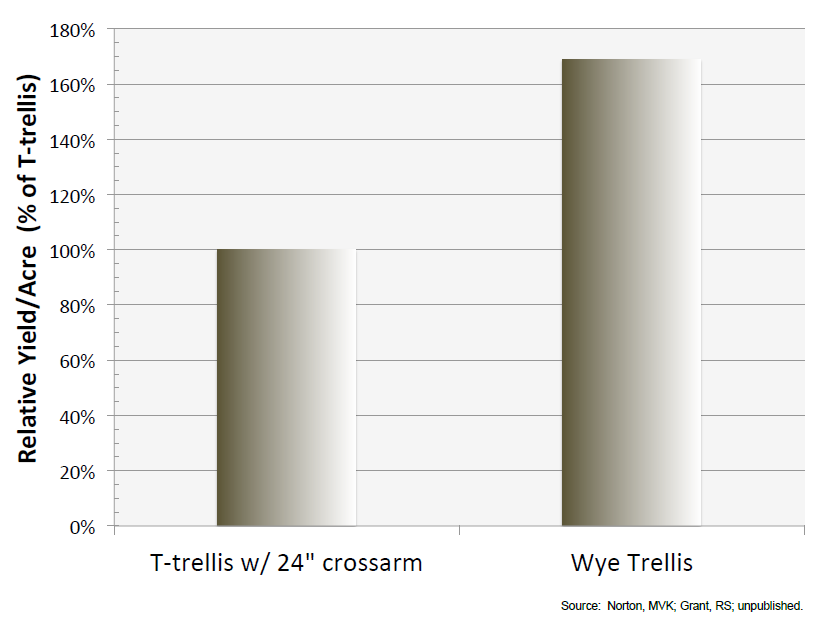MONDAY, AUGUST 31, 2020. BY STAN GRANT, VITICULTURIST.
In the California wine industry, the emphasis on grape quality has increased over the last couple of decades and for good reason – quality sets competitors apart in the grape and wine markets. However, for grape growers supplying fruit for low- and mid-priced wines, production is still the name of the game. When the price per ton is modest, a winegrape enterprise can prosper only through consistent production of high fruit yields.
The development of fruit yield is complex, involving many processes over a period of several months. Grape growers can influence some, but not all stages of yield development. Those controllable factors that reliably contribute to high yields of sound winegrapes are the topic of this article. Before discussing these factors, we first need a basic understanding of two facets of grapevine growth: capacity and balance.
Grapevine Growth Capacity and Growth Balance – Foundations of Fruit Yield
In California, most grapevines are composite plants consisting of a scion variety of a particular clone grafted onto a rootstock. Each combination of variety, clone, and rootstock has a genetic potential for growth, including the growth of fruit. Every vineyard site, with its distinct climate, aspect, and soil, imposes some limitations on the genetic growth and fruit production potential of grapevines. Past stresses and management actions also impact the vines’ production potential. Thus, the growth and fruit production of any given grapevine is the net effect of three factors: genetics, site, and history. Capacity is the term used to describe grapevine growth potential (Figure 1).

Figure 1. Two head-trained vines with different growth and fruit production capacities apparent in the differences of their woody biomass. (Progressive Viticulture©)
The term growth balance, as commonly used, refers to the ratio of berry growth to leaf growth. Growth balance is a seasonal partitioning of growth capacity between reproductive and vegetative organs, which may be altered through management actions such as pruning, irrigation, fruit thinning, and hedging. Growth balance implies a quantity of berry mass relative to a quantity of photosynthetically active leaf surfaces. In general, balance is evident during ripening as 14 to 20 well-exposed, healthy leaves per shoot with two average-sized clusters. Both too few and too many leaves relative to berry mass negatively affect fruit production, possibly in the long term as well as in the near term (Figure 2).

Figure 2. Both (A) too few leaves (overcropped) and (B) too many leaves (under cropped) limit fruit yields. (Progressive Viticulture©)
Plant Fruit Yield Factors
Some varieties and clones are more productive than others. For example, a healthy Zinfandel vine is capable of producing more fruit than a healthy Pinot noir vine. Similarly, excellent production is possible with Chardonnay-17, but production will always be limited for Chardonnay-16. Certain vineyard designs can compensate, at least in part, for varietal yield limitations on a per-acre basis, but much less so for clonal yield limitations.
High production requires a rootstock that suits the soil-borne pest population at the vineyard site, invigorates vine growth, and promotes fruitfulness. Some rootstocks, such as Salt Creek and Freedom, have reputations for high productivity, but many others are also capable of high yields (e.g. SO4 and 110R). A few rootstocks are less suited for high production vineyards, including Riparia Gloire and 420A.
An essential plant material requirement for consistent fruit yields is vines free of debilitating viruses, such as fanleaf virus and leafroll virus. Accordingly, purchasing and planting vines certified by the CDFA are decisive steps towards a productive vineyard.
Site Characteristics on Fruit Yield
A most basic requirement for high production is a favorable site that promotes timely canopy and fruit development. Many California climates are suitable for high production. Limitations occur on or near the Pacific coast where the maritime influence is strong and at high elevations where the growing season is short and the frost hazard high.

Figure 3. A deep silt loam soil in west Lodi provides a root zone that favors high fruit production. (Progressive Viticulture©)
Deep, medium-textured, well-drained, highly fertile soils facilitate high winegrape yields (Figure 3). Such soils provide large root zones, which favor the development of large, productive vines. Conversely, fruit production is limited where soils are shallow, very sandy in texture, rocky, poorly drained, low in fertility, extreme in pH, salty, or excessive in specific ions, such as sodium and chloride. High production also requires an ample supply of high-quality water carefully applied through a high performance, well-maintained drip irrigation system.
Vineyard Design Elements
Another requirement for high fruit production is a vineyard design with the following features:
1. A large number of buds, shoots, exposed leaves, and clusters per acre.
2. Shoot and leaf positioning for a high degree of leaf exposure and photosynthetic efficiency, which is the effective conversion of sunlight and water into vine biomass.
3. Provision for a favorable ratio of berry mass to leaf area (i.e. a moderate crop load) while producing high yields on a per-acre basis.
4. A relatively large quantity of vine wood per acre in the form of cordons and tall trunks, which provides reservoirs for stored nutrients.
Such designs, when done well, direct grapevine growth capacity into moderate rates of shoot elongation and balanced growth with limited management during average rainfall years.

Figure 4. Vines with a horizontally divided canopy on a Wye trellis consistently produce higher yields than vines with a single canopy on a T trellis. Both trellises have passive foliage support provided by cross-arms positioned about 14 inches above the cordons. (Data for Chardonnay vines bearing 7 feet of the cordon in trials at three locations over two years. Source: Norton, MVK; Grant, RS; unpublished).
Horizontally divided trellis systems, such as the Geneva Double Curtain or GDC (often without foliage support wires) and the Wye, possess the characteristics listed above and thereby facilitate high fruit production (Figure 4). The high wire, bilateral cordon, mechanically pruned system is an alternative high production system, that is less costly to establish and manage. In this system, canes are pruned to a length of about 8 inches on the sides and top of cordons during the dormant period (Figure 5).

Figure 5. High wire, bilateral cordon, machine pruned Cabernet Sauvignon grapevines late in the dormant period. (Progressive Viticulture©)
Space vines within rows according to their growth capacity, which usually ranges between 4 and 6 feet for horizontally divided systems and 7 to 8 feet for high wire, mechanically pruned systems. At the same time, space rows as close as possible, but at a distance that allows equipment access with minimum hedging. Row spacings are typically 11 feet for horizontally divided systems and 10 feet for mechanically pruned systems. Cordon heights commonly range between 56 to 60 inches for horizontally divided systems and 66 to 72 inches for mechanically pruned systems.
Vineyard Management Activities
The final factor affecting high fruit production is vineyard management. Prune as late as feasible because, in some situations, bud fruitfulness and yields tend to increase with the lateness of pruning. Manage early-season vineyard water and mineral nutrients for the rapid development of the complete canopies required to carry large crops to ripeness. After reaching full canopy, arrest shoot growth with moderate water stress to conserve resources and avoid negative yield effects, as well as avoid inefficiencies and expenses associated with excess foliage.
After fruit set, expeditious fruit development and maturation becomes the vineyard management focus. For maximum yields and minimal risk to fruit and leaves, maintain vines on the wetter side of moderate water stress (midday leaf water potential between -10 to -12 bars), but temporarily suspend RDI and irrigate liberally in advance of, during, and for a couple of days after periods of triple-digit maximum temperatures. Minimize other stresses, control pests and diseases, and apply mineral nutrients at appropriate times and rates to realize maximum production. These same high production vineyard management principles also apply after harvest.
In summary
Consistent high fruit production requires a systematic approach that includes a basic understanding of the underlying viticultural principles of growth capacity and growth balance, careful site selection and pre-plant preparations, a suitable vineyard design, and attentive vineyard management.
This is a modified version of an article published in the Mid Valley Agricultural Services January 2006 newsletter.
Further Reading
De Toda, FM, Sanch, JC. Long-term effects of simulated mechanical pruning Grenache vines under drought conditions. American Journal of Enology and Viticulture. 50: 87-90. 1999.
Friend, AP, Trought, MCT, Creasy, GL. Pruning to increase yield: The influence of delayed pruning time on yield components of Vitis vinifera L. cv. Merlot. In: 5th Intl. Symp. Cool Climate Viticulture. Oenol, Melborne. (unpublished).
Galet, General Viticulture.
Geller, JP, Kurtural, SK. Mechanical canopy and crop load management of Pinot gris in a warm climate. American Journal Enology and Viticulture. 64: 65-73. 2013.
Grant, S. Five-step irrigation schedule: promoting fruit quality and vine health. Practical Winery and Vineyard. 21(1): 46-52 and 75. May/June 2000.
Grant, S. The economics of vineyard design: trellising, vine spacing, and row spacing. Practical Winery and Vineyard. 20(5): 48-63. January/February 2000.
Grant, S. Balanced soil fertility management in winegrape vineyards. Practical Winery and Vineyard. 24(1): 7-24. May/June 2002.
Grant, S. Regulated deficit irrigation, parts I and II. Lodi Winegrape Commission Coffee Shop. lodigrowers.com. July 18 and August 04, 2014.
Grant, S. Vineyard longevity. Progressive Viticulture. progressivevit.com. March 26, 2015.
Grant, S. Fruit set factors. Lodi Winegrape Commission Coffee Shop Blog. lodigrowers.com/improving-fruit-set/. May 20, 2016.
Grant, S. Selecting a rootstock for a winegrape vineyard. Grant, S. Lodi Winegrape Commission Coffee Shop. lodigrowers.com/selecting-a-rootstock-for-a-winegrape-vineyard/. October 07, 2016.
Grant, S. Vineyard design and management for maximum efficiency. Lodi Winegrape Commission Coffee Shop. lodigrowers.com/vineyard-design-management-for-maximum-efficiency/. February 22, 2018.
Grant, S. Vine growth capacity and horizontally divided vines. Lodi Winegrape Commission Coffee Shop. lodigrowers.com/vine-growth-capacity-and-horizontally-divided-vines/. June 03, 2019.
Howell, GS. Sustainable Grape Productivity and the Growth-Yield Relationship: A Review. American Journal of Enology and Viticulture. 52: 165-174. 2001.
Lodi Winegrape Commission. Mechanical pruning field day. lodigrowers.com/mechanical-pruning/.
Keller, M. The science of grapevines. Academic Press, Burlington, MA. 2010.
Kurtural, SK, Beebe, AE, Martinez-Luscher, J, Zhuang, S, Lund, KT, McGourty, G, Bettiga, LJ. Conversion to Mechanical Pruning in Vineyards Maintains Fruit Composition while Reducing Labor Costs in ‘Merlot’ Grape Production. HortTechnology. February 2019.
Norton, MVK. Mechanical pruning of winegrapes. cestanislaus.ucanr.edu/files/111478.pdf
Terry, DB, Kurtural, SK. Achieving vine balance of Syrah with mechanical canopy management and regulated deficit irrigation. American Journal of Enology and Viticulture. 62: 426-437. 2011.
Winkler, AJ, Cook, JA, Kliewer, MK, Lider, LA. General Viticulture. University California Press, Berkeley, 1974.
Have something interesting to say? Consider writing a guest blog article!
To subscribe to the Coffee Shop Blog, send an email to stephanie@lodiwine.com with the subject “blog subscribe.”
To join the Lodi Growers email list, send an email to stephanie@lodiwine.com with the subject “grower email subscribe.”
To receive Lodi Grower news and event promotions by mail, send your contact information to stephanie@lodiwine.com or call 209.367.4727.
For more information on the wines of Lodi, visit the Lodi Winegrape Commission’s consumer website, lodiwine.com.


